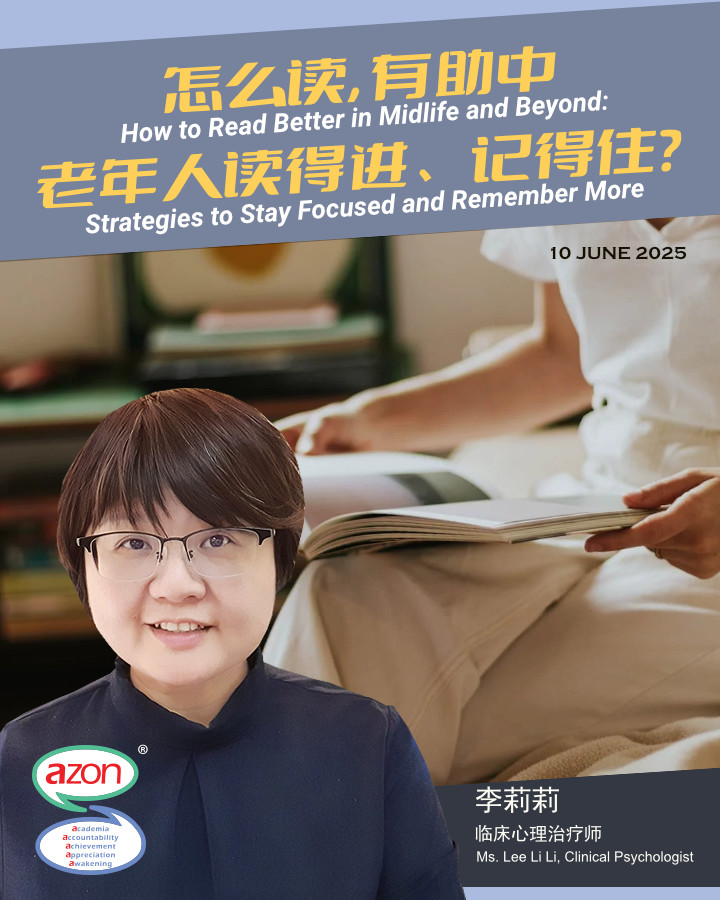
Title: How to Read Better in Midlife and Beyond: Strategies to Stay Focused and Remember More
Speaker: Ms Lee Li Li, Clinical Psychologist
Date: 10.06.2025 (Tuesday)
"Sometimes I wonder if I am reading the book, or if the book is reading me." Many older adults are picking up reading as a habit, yet they often face challenges: fatigue, forgetfulness, or trouble focusing. These challenges can make midlife hard to retain what they read. Neuroscientists have found that reading regularly helps activate and strengthen the brain. Thus, this highlighted that brain health is especially important for middle-aged and older adults.
A. How to Make Reading More Enjoyable?
Creating a comfortable reading environment
Choose books that match your interests
B. How to Read a Book Effectively?
1. Preview Reading
Previewing the table of contents helps plan reading and understand what to expect in each chapter, while warm-up activities help midlife understand whole concept of a book and reduce reading resistance.
2. Speed reading
C. How to Stay Focused and Retain What You Read?
Speaker: Ms Lee Li Li, Clinical Psychologist
Date: 10.06.2025 (Tuesday)
"Sometimes I wonder if I am reading the book, or if the book is reading me." Many older adults are picking up reading as a habit, yet they often face challenges: fatigue, forgetfulness, or trouble focusing. These challenges can make midlife hard to retain what they read. Neuroscientists have found that reading regularly helps activate and strengthen the brain. Thus, this highlighted that brain health is especially important for middle-aged and older adults.
A. How to Make Reading More Enjoyable?
Creating a comfortable reading environment
- Find suitable reading posture: Whether it’s sipping coffee while reading, standing up, or sitting down, comfort matters.
- Reading environment: Reading outdoors, in a well-lit room, with soft background music, or surrounded by the aroma of fresh coffee can all make reading more enjoyable.
Choose books that match your interests
- Popular genres for midlife: Health and wellness, spiritual enrichment, motivation and self-development, and hobby-related books.
- Use simple, accessible language: Avoid books with overly complex plots or difficult vocabulary. Instead, prioritize clear storytelling and engaging, easy-to-understand content.
- Memory retention: Reading something you genuinely enjoy boosts motivation, leading to better memory.
B. How to Read a Book Effectively?
1. Preview Reading
- Skim first: Read the title, table of contents, or introduction to get a general understanding of the book.
- Warm up: If the book has an audiobook version, film, stage play, or comic adaptation, this enables midlife to build their interest and understanding easily.
Previewing the table of contents helps plan reading and understand what to expect in each chapter, while warm-up activities help midlife understand whole concept of a book and reduce reading resistance.
2. Speed reading
- Break free from traditional reading: Word-for-word reading often slows down the brain and makes it harder to remember.
- Purposeful reading: It is important to know why you're reading, whether for personal interest or a specific goal. By having a clear purpose, this could boost motivation.
- Eyes training: As you read quickly, your eyes naturally pause or move. Pauses help absorb information, while movement reflects active reading.
- Speed eye movement:
- Flexibility training: Move your eyes up, down, left, right, and in circles (clockwise and counterclockwise).
- Focus training: Follow the tip of a pen with your eyes or do eye-rotation exercises to build concentration.
- Line-jumping: Practice moving your eyes from the end of one line directly to the beginning of the next.
- )Expand visual field: Use peripheral vision to capture more words at once.
C. How to Stay Focused and Retain What You Read?
- Set a clear reading goal: Knowing what you want to get out of the book before choosing it.
- Engage multiple senses: Avoid reading aloud or silently mouthing the words. Instead, read quickly, visualize the information, and use physical movement to reinforce memory.
- Activate prior knowledge: Share what you’ve read with others. For example, join a book club or talk about your takeaways, which could strengthen your memory through retrieval.
- Review and relate: Reflecting on the reading experience and how it connects to own life can make each book feel more meaningful and memorable.





